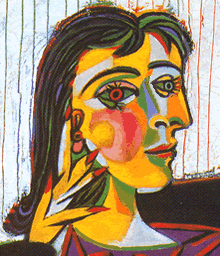|
 |
Portrait of Dora Maar
 |
 |
|
Pablo Picasso, Portrait of Dora Maar Seated, 1937, Oil on Canvas, 92 x 65 cm.
|
Pablo Picasso's Portrait of Dora Maar Seated, (1937) has been the source of several of my early attempts to paint an image onto the Centaur form. (Notably Drawings #1, #2 and #3).
During recent efforts to create a 3D version of Dora Maar on the Centaur form, I have been able to distinguish the underlying structure of the Dora Maar portrait and get an insight into Picasso's Cubist methods.
With a typical perspective based drawing we are able to view the entire frame of the image in a single snapshot. This is the essential nature of a perspective drawing, that it is take from a single viewpoint in a single moment of time.
In contrast, Cubism aims to provide several viewpoints of a single object. This makes it more difficult for the viewer to 'see' the entire image in a single glimpse. Typically, we need to look at several parts of the images to register the different pieces. Instead of 'seeing the image in a single glance', we need to 'read the various elements of the image'.
With a little help from some photo editing software we can dissect Picasso's Dora Maar and see the underlying structure of the face and gain an insight into Pablo's methodology.
Below we have two versions of Dora Maar. On the left is the face as it is painted. On the right the image has been edited to remove the right hand side of the face. The result is rather astonishing. Instead of a disjointed face with irregular shaped features, we can view a beautiful young girl with soft and round features. Also, we can see that almost 80% of the Cubist face fits very closely to a perfectly proportioned traditional face.
 |

|
 |
Left: An enlarged view of Dora Maar's head.
Right: An edited view of half of Dora Maar's face
|
If we now focus on the left hand image and compare this to the segment that is missing in the right hand image, there are two more elements that deserve to be highlighted.
Firstly, the right eye has the eyelashes pointing to the left when we would probably expect them to be pointing to the right. As such, the eye appears to be reversed (looking to the left rather than the right).
With a little help from some computer editing, we can flip the eye and point it to the right. If we were intending to create a perspective based image or traditional portrait, the overall shape of the eye, including the eyelid and eyelashes would now be 'correct'. The eye ball, consisting of a black circle with a black dot and green base, contrasts this effect by looking directly at the viewer rather than in the direction of the eyelashes.
Overall, through rotating the eye we remove one of the key Cubist elements of this Portrait of Dora Maar. This also points to the importance of the 'eye' as a key point in facial recognition.
 |

|
 |
Left: An enlarged view of Dora Maar's head.
Right: An edited view with the right eye rotated 180 degrees and flipped upside down.
|
The second point of interest is the two noses in the portrait, they give the illusion of a turning face.
The first nose can be seen in the left hand image below, along the line where the image has been edited (the green line and the violet triangle form the bridge of the nose). The second nose can be seen in the right hand picture below, as the right hand, black lined edge of the face clearly contrasting against the white background of the wall behind the head.
 |

|
 |
Left: An edited view of half of Dora Maar's face.
Right: Another view edited further to highlight the profile of the face and with the right eye rotated 180 degrees and flipped upside down.
|
The black lined nose (right) can be read as a silohuette or profile whereas the green line and violet triangle (left) can be read as a nose in a three-quarter view (neither front on or side on). Picasso uses two different means to define the noses. For the profile he uses a hard black line edge giving the nose a two-dimensional quality. For the other, shape and colour is used to create the three dimensional qualities of the nose.
The red lips also accentuate the same shift. The horizontal red lips are shown in a three quarter view and are edged by a black line that can be read as a profile view.
The two different noses, the lips and other cues, give the effect of a face turning from the three quarter to the profile. Picasso has cleverly devised a way to show two distinct positions of a turning face in a single frame.
Whilst Picasso was often derided for his seemingly childlike paintings, the subtle use of colour and perspective in the 'Portrait of Dora Maar Seated' exhibits his true genius. He was able to marry elements of traditional portraiture and perspective with the cubist framework to produce a truly unique portrait.
|
 |
| |
|
|

|
|





![]()
